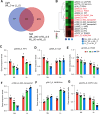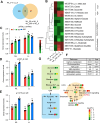Integrative analysis of transcriptome and metabolism reveals functional roles of redox homeostasis in low light and salt combined stress in Leymus chinensis
- PMID: 40158098
- PMCID: PMC11955115
- DOI: 10.1186/s12864-025-11526-9
Integrative analysis of transcriptome and metabolism reveals functional roles of redox homeostasis in low light and salt combined stress in Leymus chinensis
Abstract
Salt stress is one of the major limiting factors of Leymus chinensis (named sheepgrass) growth, which accelerates inhibitive effects that are particularly concomitant with low light regimes (LL-Salt). However, little is known about physiological and molecular mechanisms under such LL-Salt in sheepgrass. This study aims to uncover the key reprogrammed metabolic pathways induced by LL-Salt through an integrated analysis of transcriptome and metabolism. Results suggested that the growth of sheepgrass seedlings was dramatically inhibited with a ranging of 8 to 20% reduction in Fv/Fm in LL-Salt combined treatments. Catalase activities were increased by 40% in LL but significantly decreased in salt stress, ranging from 15 to 46%. Both transcriptome and metabolism analysis reveal that carbon metabolism pathways were significantly enriched in the differentially expressed genes with downregulation by both LL and salt stress treatment. Metabolites involved in the photorespiration pathway, including serine and glycolate, were downregulated in LL while upregulated in salt stress treatment, with the same pattern of expression levels of a photorespiration regulatory gene, glycolate oxidase. Collectively, we found that serval antioxidant redox pathways, including photorespiration, GSG/GSSH redox, and ABA signaling, participated in response to LL and salt combined events and highlighted the roles of cellular redox homeostasis in LL-Salt response in sheepgrass.
Keywords: Antioxidant; Carbon metabolism; Photorespiration; ROS; Sheepgrass; TCA; Transcriptome.
© 2025. The Author(s).
Conflict of interest statement
Declarations. Ethics approval and consent to participate: Our rice collection work complies with the laws of the People’s Republic of China and has a permission letter from the Institute of Grass Research, Heilongjiang Academy of Agricultural Sciences. Voucher specimens were identified by Prof. Wei Li (Heilongjiang Academy of Agricultural Sciences) and kept at Heilongjiang Rice Quality Improvement and Genetic Breeding Engineering Research Center (No: SG001-SG058). All methods were carried out in accordance with relevant guidelines and regulations. Consent for publication: Not applicable. Competing interests: The authors declare no competing interests.
Figures







References
-
- Panigrahy M, Majeed N, Panigrahi KC. Low-light and its effects on crop yield: genetic and genomic implications. J Biosci. 2020;45(1):102. - PubMed
-
- Peng X, Ma X, Fan W, Su M, Cheng L, Iftekhar A, et al. Improved drought and salt tolerance of Arabidopsis thaliana by transgenic expression of a novel DREB gene from Leymus chinensis. Plant Cell Rep. 2011;30:1493–1502. - PubMed
-
- Munns R, Tester M. Mechanisms of salinity tolerance. Annu Rev Plant Biol. 2008;59(1):651–81. - PubMed
MeSH terms
Grants and funding
LinkOut - more resources
Full Text Sources

